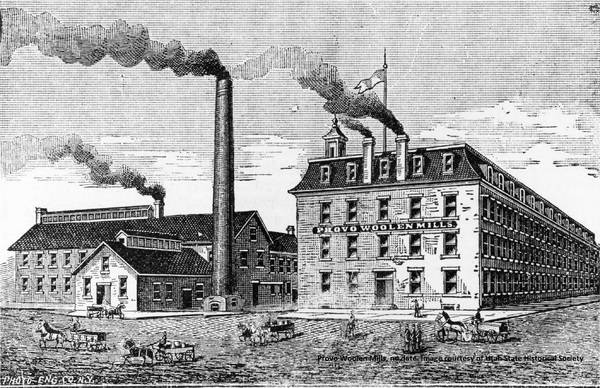Dublin Core
Title
Description
Learn about the Provo Woolen Mills, the first large factory built in Utah.
Prior to the coming of the transcontinental railroad in 1869, Utah's economy revolved mainly around agriculture, barter, and small-scale manufacturing. With the railroad, however, the massive machinery needed to start large-scale manufacturing could be shipped to the territory, and local products could be sold from coast to coast. This new connection to larger markets inspired LDS Church leaders to build the first large factory in Utah.
Sheep were the inspiration. Sheep thrived in Utah and wool had been successfully processed here on a small scale. So church leaders organized the Timpanogos Manufacturing Association and began construction on a woolen mill in downtown Provo. Skilled builders from all over the territory helped with the project. Local residents donated labor, materials, and cash in exchange for stock in the planned enterprise. When money ran short, the city of Provo gave wheat for the workmen, and Utah County sold its courthouse to the new corporation in exchange for stock. Cash for the machinery – which was shipped from Philadelphia – came from the LDS Church and private investors.
Built on the Provo River to harness the hydro-power, the Provo Woolen Mills employed about 150 workers, mostly young women and recent British migrants who already had experience in textile manufacturing. The factory’s main building was an imposing four stories tall. Looms lined the first two floors, while spinning and carding machines filled the rest. Behind the main building were three adobe structures where the fleece was sorted and washed, and sometimes dyed before being spun and woven into cloth. Surplus power from the plant's turbines was sold to Provo City to power streetlights.
The fabric manufactured at the Provo Mill made it into local homes, although much of its product was exported to nearby states, thanks to the new railroad links. By the twentieth century, the Provo factory could no longer compete with eastern mills, and its doors finally closed in 1932. By that time, however, large-scale industry was firmly established in Utah.
Creator
Source
Image: Provo Woolen Mills, P. 5, no date, no. 6005. Image courtesy of the Utah State Historical Society.
_______________
See Sharon S. Arnold, “The First Large Factory in Utah,” Beehive History 6, Utah State Historical Society, https://heritage.utah.gov/history/uhg-first-large-factory; and Richard Neitzel Holzapfel, A History of Utah County (Salt Lake City: Utah State Historical Society and Utah County Commission, 1999), pp. 108, 149-150, and 152.

